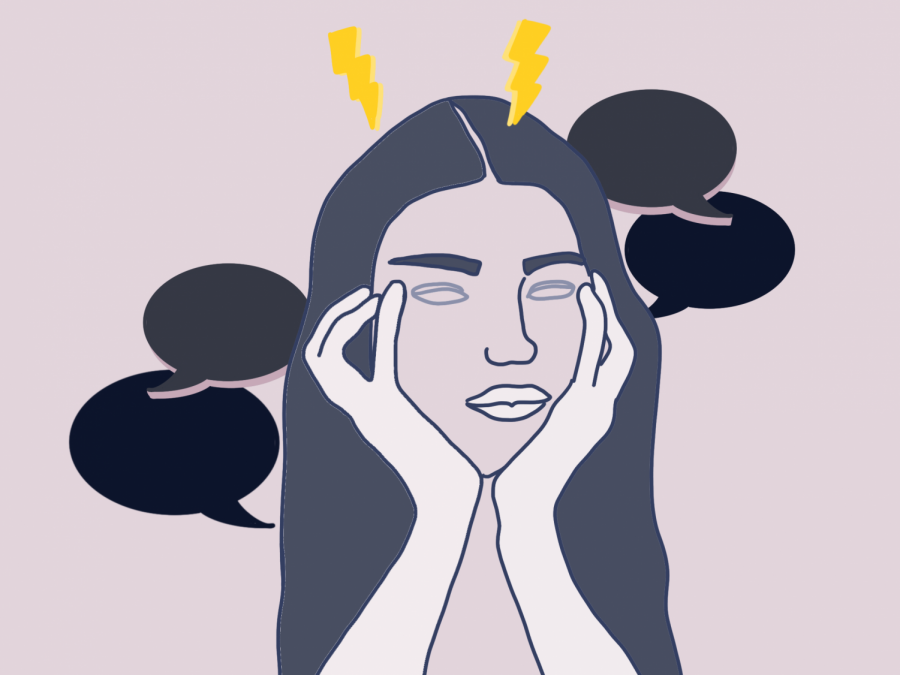Opinion | We can’t neglect psychotic illnesses
October 6, 2020
Warning: This column contains content relating to mental illness, which some readers may not be comfortable with. If you are struggling with mental health problems, consider contacting the University Counseling Center.
We have, over the past decade, come a long way in opening conversation around mental illness. Or, at least, certain mental illnesses.
Celebrities have dedicated their platforms to mental health. Depression is represented on television shows, and more and more people seem to be understanding that it’s not laziness or a bad day — but a serious mental illness. We’re starting to open conversations about more inclusive eating disorder treatment, and college students now have access to resources like campus dieticians. It’s nowhere near perfect, though at the very least, we’re trying. But while some mental illnesses have become more acceptable to talk about, others — specifically any kind of psychotic illness — have been left behind.
Psychosis — by definition — is a loss of contact with reality. During a psychotic episode, no matter how brief, a person’s thoughts and perceptions are altered, and they might have a difficult time deciphering between what is real and what isn’t. They might also hallucinate, disassociate from their body or location and experience delusions. Other symptoms include incoherent speech and detached, inappropriate behavior. When someone is experiencing psychosis, it can be obvious, but it can also be discreet. At least 4% of the American population has a psychotic illness. Whether obvious or not, chances are, you know at least someone with one.
Aside from schizophrenia and schizoaffective disorder — for which psychotic symptoms are necessary for diagnosis — most other psychotic illnesses are more difficult to parse. Bipolar is technically a psychotic illness, although some people with bipolar only experience hypomania — a more mild form of mania, which includes euphoria, increased energy and decreased need for sleep, but often excludes psychosis. Borderline personality disorder, especially when the person is under duress, can sometimes include psychotic symptoms. About 20% of people with major depressive disorder simultaneously experience symptoms of psychosis. There’s also a subtype of post-traumatic stress disorder — PTSD-SP — that includes trauma-induced psychosis. And though it isn’t at the moment, some researchers argue that anorexia should be classified as a psychotic illness due mainly to extreme body image distortions.
For some people, psychosis is a chronic experience, or at least, something that comes and goes. But not everyone who experiences psychosis has a psychotic illness, or any kind of mental illness with psychotic symptoms. The National Institute of Mental Health estimates that 3% of people will have an unprecedented psychotic episode — often referred to as a psychotic break — at some point in their life. It may happen only once, and it might not be induced by a mental illness. Severe sleep withdrawal, for example, can cause psychosis. Substance-induced psychosis is often a symptom of drug withdrawal, and physical illnesses — often autoimmune diseases like lupus, AIDS and multiple sclerosis — can result in psychosis, too.
When I was diagnosed with bipolar a few years ago, I thought my life was over. Not because of what my clinicians told me, but because in high school health class, and even my college psychopathology class, I learned that psychosis was the worst thing that could possibly happen to a person. In reality, it’s unpleasant. Sometimes I don’t even notice it. On rare occasions, it’s debilitating — though I’m not sure it’s any more debilitating, at least for me, than any other mental illness I’ve had.
Not every person with a psychotic illness is high-functioning, just like not everyone with depression is high-functioning. There are a lot of factors that play into this — such as genetics, environment, age of symptom onset and course of treatment. But often with proper adjustment time, and usually a lot of trial and error, proper medication and therapy makes psychosis relatively manageable. Most people with psychotic illnesses will continue to show symptoms, at least intermittently, but can live full lives.
Increased stigma is correlated with decreased treatment, which is to say, the less we talk about psychotic illnesses, the less people are going to feel comfortable seeking treatment. There are so many barriers that prevent adequate treatment — health insurance, income, race and education, to name a few. I know that working to end stigma won’t fix all of these. But I do know that it’s one fewer barrier. And I know that upwards of 40% of people with schizophrenia and about 20% of people with bipolar attempt suicide at least once in their lifetime. I know that if people had proper treatment, these numbers would not be zero — but they would be lower.
One of the sweetest things about curbing mental illness stigma is being able to talk about it without being harshly judged, and without people making assumptions about you. I don’t think we’re in this place with psychotic illnesses. I don’t think we’re even close. They are still taboo and frankly, they’ve been left behind. I want us to bring them to the table the way we have other mental illnesses.
To be clear, I don’t think we’ve done nearly enough to de-stigmatize depression, anxiety disorders and eating disorders, either. But the effort and commitment is clearly there. I am so grateful for the work clinicians and everyday people have done over the past decade to push the conversation around mental health forward. But we just can’t progress in de-stigmatizing mental illness while neglecting psychotic illnesses.
Leah writes primarily about plants, wellness culture and the spices of the world. Write to them at LEM140@pitt.edu.




